Investigating the Manifestation of Sacredness in Iran’s Holy Shrine’s Architecture: The Case of Imam Reza’s (AS) Holy Shrine
Architecture, beyond the technological matter, means the totality of human presence in the world; Therefore, the sacred as the most basic feature of human presence in the world has an essential relation with architecture. This relationship is established, on the one hand, with the temple and on the other hand, with religious prayers and rituals. Iranian architecture is one of the most valuable examples of indigenous architecture that has unique features, including semantic, mystical and conceptual features such as the sacredness. Throughout history, religious buildings, especially the tombs of imams and great men of science, have taken different forms and it seems that differences in the way of manifesting attributes and concepts have caused physical differences in them. This difference is crystallized not only in the physical features of architecture in general but also in details such as decorations. Because tombs have been used as shrines in Islamic lands and for this reason, they have been considered in terms of art. Architects have also sought to create a sacred place throughout history and have used the realm of meaning to achieve this. The most obvious semantic and essential manifestation of man can be explored in sacred art. In general, sacred art is summarized in meaning, which has emerged in the body of architecture. Sacred art is a reflection of the spiritual world, and this view emphasizes that sacred architecture is not just a place for human habitation and physical need, but also causes human growth and excellence in human space. This research intends to review the manifestation of the holy order in the tomb of Imam Reza (AS), the eighth Imam of the Shiites. The purpose of this study is to investigate the place of the sacredness in architecture as a visual art and to find the ideas formed in the body of the building. This study is qualitative and of argumentative and analytical type, so that the architecture of the tomb is examined theoretically based on the principles of the sacredness and based on logical reasoning. In this research, first the concept of the sacred matter has been studied and then according to the subject of place (the holy court of Imam Reza (AS)), the concepts of the sacred matter have been evaluated and reviewed. According to the findings of the studies done so far, the analyses show that Islamic architecture has used the sacred in terms of form and meaning, so that concepts such as signs and symbols, the originality of the tomb in organizing the spaces of the tomb, the location of the tomb in the space inside, the use of luxurious and richly decorated materials and the existence of a spatial hierarchy to reach the shrine (providing various spaces for the mental and spiritual preparation of the pilgrim, taking the pilgrim by various spaces and compassion and kindness with him, approaching the stage step by step to the beloved and perfect human being, attention and in essence, placing a perfect human being, instilling the feeling of meeting an important person (who has emerged in the holy shrine of Imam Reza (AS).
- حق عضویت دریافتی صرف حمایت از نشریات عضو و نگهداری، تکمیل و توسعه مگیران میشود.
- پرداخت حق اشتراک و دانلود مقالات اجازه بازنشر آن در سایر رسانههای چاپی و دیجیتال را به کاربر نمیدهد.


